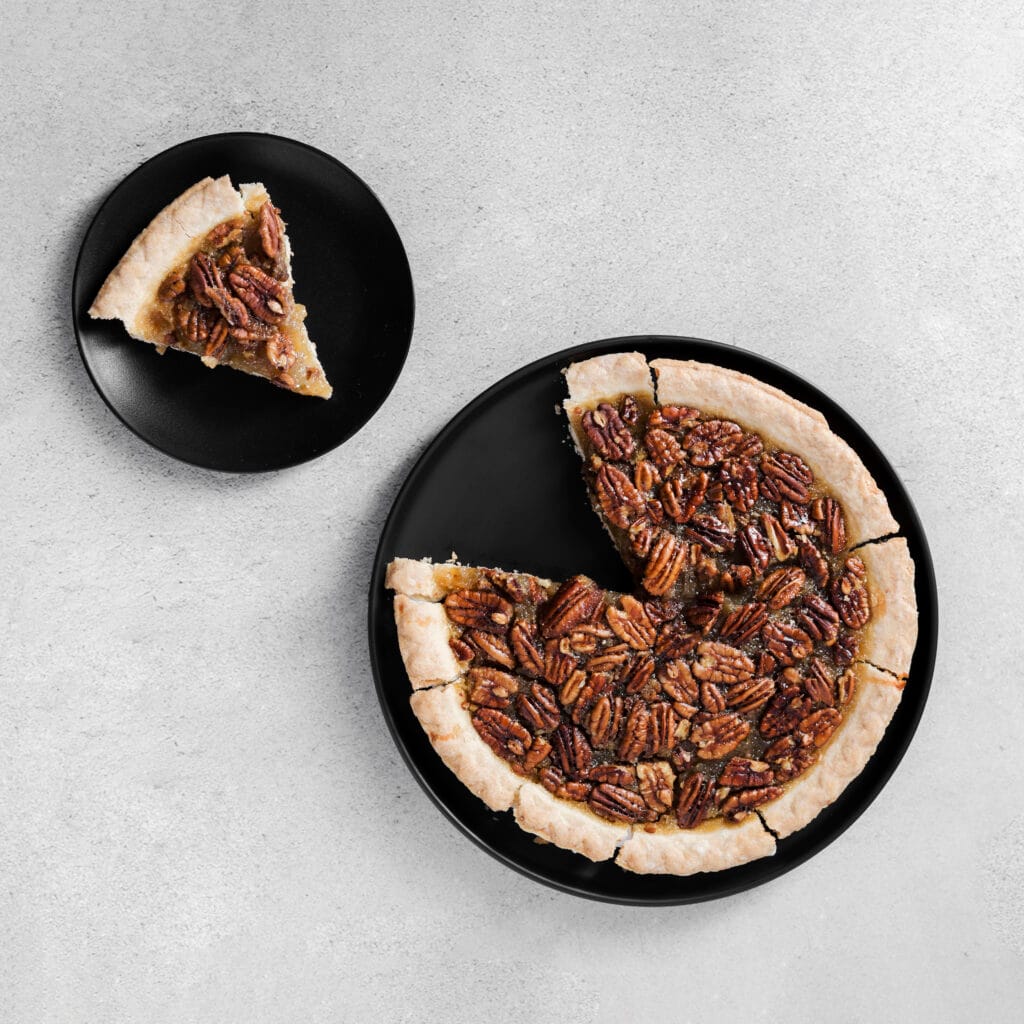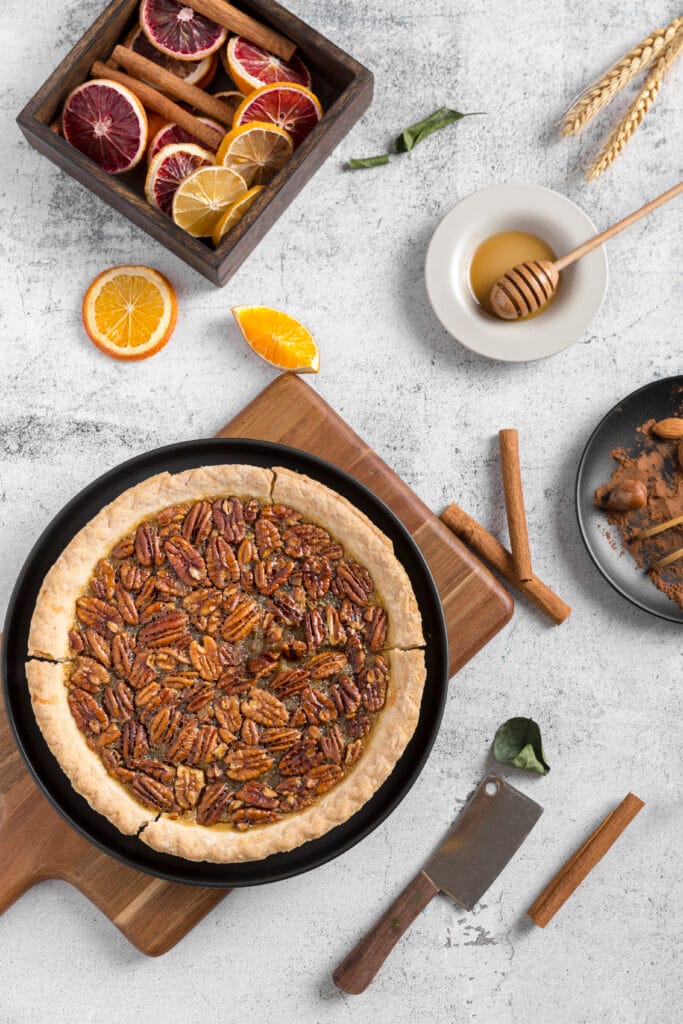Why is the middle of my pecan pie still liquid? This common issue can be frustrating, especially after carefully following a recipe. Often, it happens due to baking mistakes such as improper ingredient ratios or underbaking. In this article, we’ll explore the reasons behind a runny pecan pie filling and provide practical solutions to fix and prevent it in the future.
Table of Contents
How to Fix a Runny Pecan Pie Filling
A perfectly baked pecan pie strikes a delicate balance between structure and softness:
- The filling should be gel-like and firm, not watery or overly stiff.
- The pie should hold its shape when sliced, with the center slightly gooey but not liquid.
- The crust must be golden brown and crisp, providing a sturdy base for the filling.
If your pie doesn’t meet these expectations, there’s likely an issue with the recipe, baking process, or cooling time.
For a deeper dive into the science of pie baking, you might want to consult this guide on perfecting pie textures.
Preventing Liquid Centers in Pecan Pie
The middle of a pecan pie can stay liquid for several reasons. Understanding these causes is the first step in resolving the issue.
1. Common Causes of a Runny Pecan Pie Filling
The custard-like filling in pecan pie relies on precise ratios of eggs, sugar, and syrup. Common mistakes include:
- Using too much corn syrup or sugar, which can overwhelm the eggs’ ability to bind the filling.
- Using too few eggs, reducing the structural integrity of the custard.
If you’re exploring substitutes for corn syrup, such as honey or maple syrup, be aware that they can alter the texture. For insights on substitutes, read this guide to corn syrup alternatives.
2. Key Baking Tips for Perfect Pecan Pie Consistency
Baking at the wrong temperature is another common culprit:
- An oven that runs cooler than the set temperature may prevent the filling from reaching the necessary temperature to set properly.
- Use an oven thermometer to ensure an accurate reading, as ovens often have calibration discrepancies. Learn how to calibrate your oven here.
3. Fixing Undercooked Pecan Pie Centers
The filling in pecan pie requires sufficient time at the right temperature to thicken. Removing the pie too early is one of the most frequent causes of a runny center. The pie needs to reach an internal temperature of 200°F (93°C) to ensure the eggs and sugar have gelled into a stable custard.
4. Improper Cooling
Even if the pie appears liquid when removed from the oven, it often thickens as it cools. Cutting into the pie too soon can give the illusion of underbaking when the filling simply hasn’t had time to set.
5. Environmental Factors
Humidity and high altitude can also affect the consistency of pecan pie. At high altitudes, adjustments to baking time and temperature are often necessary. For detailed guidance, check out tips on baking at high altitudes.

Fixing a Runny Pecan Pie
If your pecan pie’s middle is still liquid after baking, don’t worry—there are ways to save it.
1. Let It Cool Completely
Freshly baked pies often seem runny because the filling hasn’t had time to set. Allow your pie to cool for at least 2-4 hours at room temperature. This cooling period allows the custard to thicken naturally.
2. Re-bake the Pie
If cooling doesn’t resolve the issue, you can re-bake the pie:
- Preheat the oven to 325°F (160°C).
- Cover the edges of the crust with aluminum foil to prevent overbrowning.
- Bake the pie for an additional 15-20 minutes, monitoring the center closely.
3. Thicken the Filling
For future pies, you can incorporate a thickener, such as:
- Cornstarch: Whisk 1-2 tablespoons into the filling mixture.
- All-Purpose Flour: A similar quantity can be used for binding.
Preventing Runny Pies in the Future
Prevention is key when it comes to achieving the perfect pecan pie. Here are detailed steps to avoid common pitfalls:
1. Perfect the Ingredient Ratios
Stick to the classic proportions:
- 1 cup of corn syrup or a suitable substitute.
- 1 cup of sugar.
- 3 large eggs for proper binding.
- 1 cup of pecans for texture.
Avoid substituting ingredients unless the recipe accounts for their differences. For example, using maple syrup or honey can yield a thinner filling unless additional thickeners are added.
2. Prebake the Crust
Blind baking (prebaking) the crust helps ensure that the filling bakes evenly. To do this:
- Line your crust with parchment paper and fill it with pie weights.
- Bake it at 375°F (190°C) for 10-15 minutes before adding the filling.
3. Monitor Baking Time and Temperature
Bake the pie at 350°F (175°C) for 60-70 minutes. Keep these cues in mind to determine doneness:
- The edges should be set while the center jiggles slightly.
- The top should be golden brown and puffed up.
Common Misconceptions About Pecan Pie
1. Overbaking Fixes Runny Centers
While it might seem logical to bake the pie longer, overbaking can lead to a hard crust and overly dry edges. The key is achieving a precise bake, not just extending the time.
2. Ingredient Substitutions Are Always Equal
Many assume that substitutes like honey or maple syrup will behave the same as corn syrup. However, these alternatives have different consistencies and sugar content, which can affect the final texture of the pie.
Creative Ideas for Pecan Lovers
Pecan pie isn’t the only way to enjoy this nutty flavor. For something new, explore this pecan pie dip recipe or learn about flavor combinations that pair well with pecans. These ideas offer exciting ways to incorporate pecans into your desserts and snacks.
FAQs About Runny Pecan Pie
Why is my pecan pie leaking?
Leaking typically occurs when the filling isn’t properly emulsified or hasn’t been baked long enough to set. Ensure that the sugar, eggs, and syrup are thoroughly mixed before baking.
Can I eat a runny pecan pie?
While a slightly runny pie is safe to eat if it has reached 165°F (74°C), its texture and presentation will suffer.
How do I store pecan pie?
Refrigerate your pecan pie in an airtight container for up to 4 days. Reheat slices in the oven at 300°F (150°C) for about 10 minutes to restore their texture.
Is corn syrup necessary for pecan pie?
While traditional recipes use corn syrup, you can substitute it with options like maple syrup or honey. However, adjustments to the recipe may be needed to maintain the right consistency.
Conclusion
The secret to avoiding a liquid middle in pecan pie lies in mastering the balance of ingredients, baking at the correct temperature, and allowing sufficient cooling time. By understanding and addressing the factors that lead to a runny center, you can confidently bake a pecan pie that is as visually appealing as it is delicious.
For more inspiration, explore creative twists like the pecan pie dip recipe or delve into complementary pecan flavor pairings. With these tips and tricks, your next pecan pie is sure to be a success. Happy baking!


